Reading are yet to benefit from ‘new manager bounce’ as their misery continued into the new year under Jose Gomes. In this tactical analysis, we’ll look in detail at how Swansea City were able to win emphatically at the Madejski Stadium and why the signs don’t look good for Reading.
On this New Year’s Day viewing, it’s not difficult to see why Reading have seen no improvement since December’s sacking of former Real Madrid assistant Paul Clement. After the heavy 4-1 defeat that saw Swansea do the damage in the first 45 minutes, scoring three goals without reply, Reading boss Gomes admitted that his players were “scared”.
The Royals’ lack of confidence was there for all to see as they were already stunned within 90 seconds. Oli McBurnie got between two defenders before brilliantly heading home Kyle Naughton’s cross from the right flank.
Swansea City desperately needed to re-establish themselves after a disappointing run of results and performances over the festive period. McBurnie’s opener within the opening two minutes was the perfect response.
The early goal meant that both sides had polar opposite confidence. You could only see things getting worse for Reading, although the Swans took another 28 minutes to extend their lead. Defenders Connor Roberts and Mike van der Hoorn both found the net before the break.
Potter gets his team selection right
Swansea City manager Graham Potter was heavily criticised for his bizarre 3-5-2 formation and line-up choices against Wigan Athletic. Both effectively gave his side an early two-goal deficit. They came back to rescue a point after Potter fixed his own errors at half time. The former Ostersunds boss saw the error of his ways and reverted back to this season’s preferred 4-2-3-1 system.
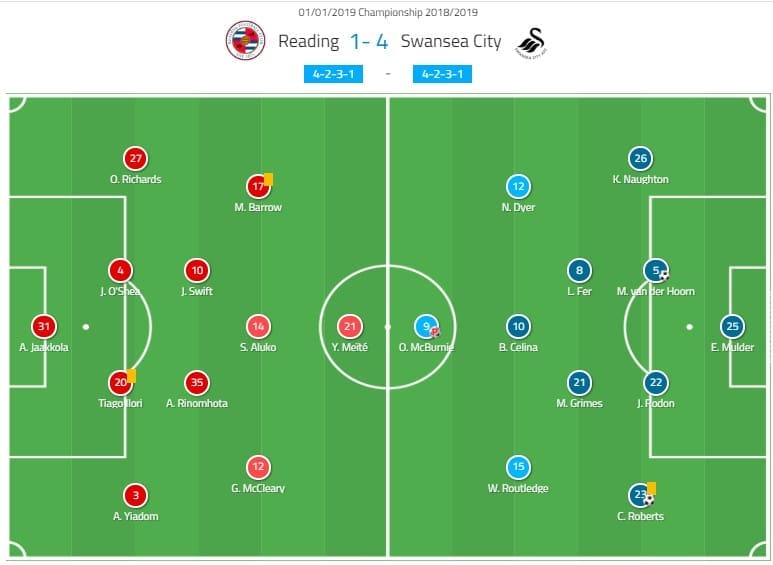
Reading also lined up in a 4-2-3-1 with Meite leading the line ahead of Aluko just behind.
Celina and McBurnie’s attacking partnership
Swansea City benefited from Bersant Celina playing in closer proximity to striker Oli McBurnie. The Kosovan did however drift wide on occasion to ensure balanced width on both sides of the pitch.
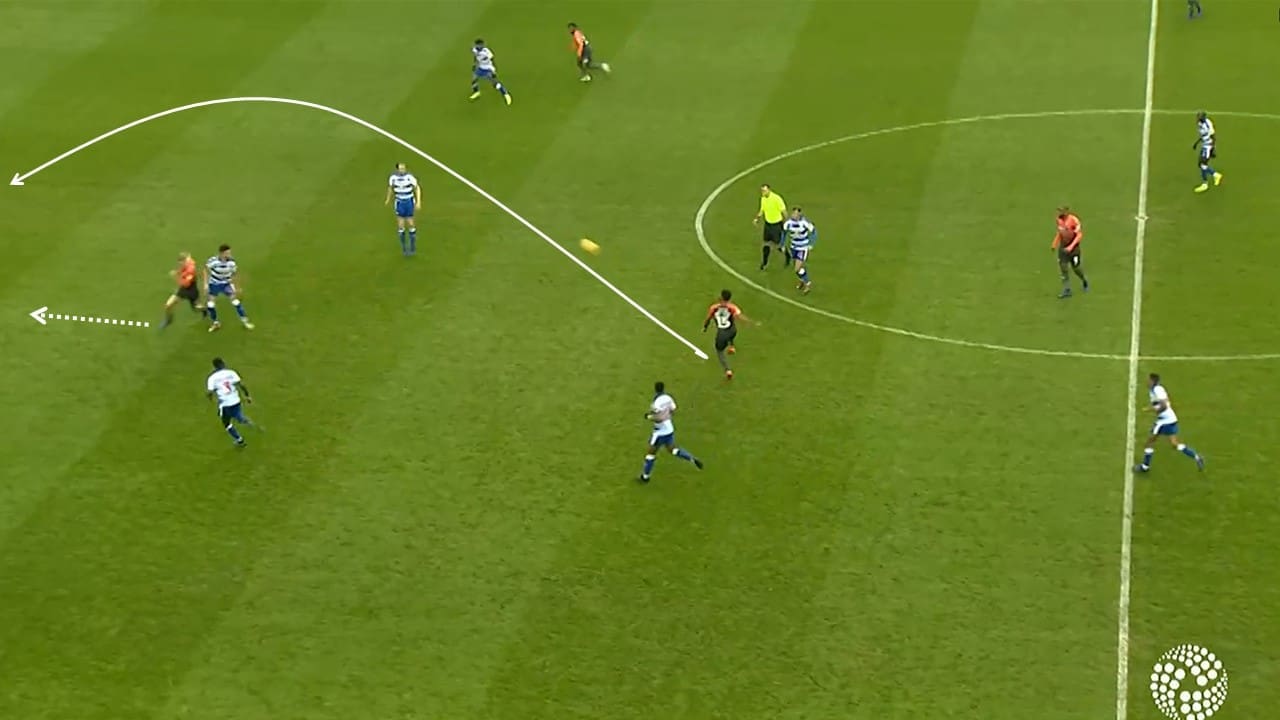
Scottish international forward McBurnie also averaged a higher position than in recent weeks too. He usually likes to drop deep into midfield, or wide to help link up play down the right wing. At Reading he was more central, often playing off the last defender: a rare sight this season.
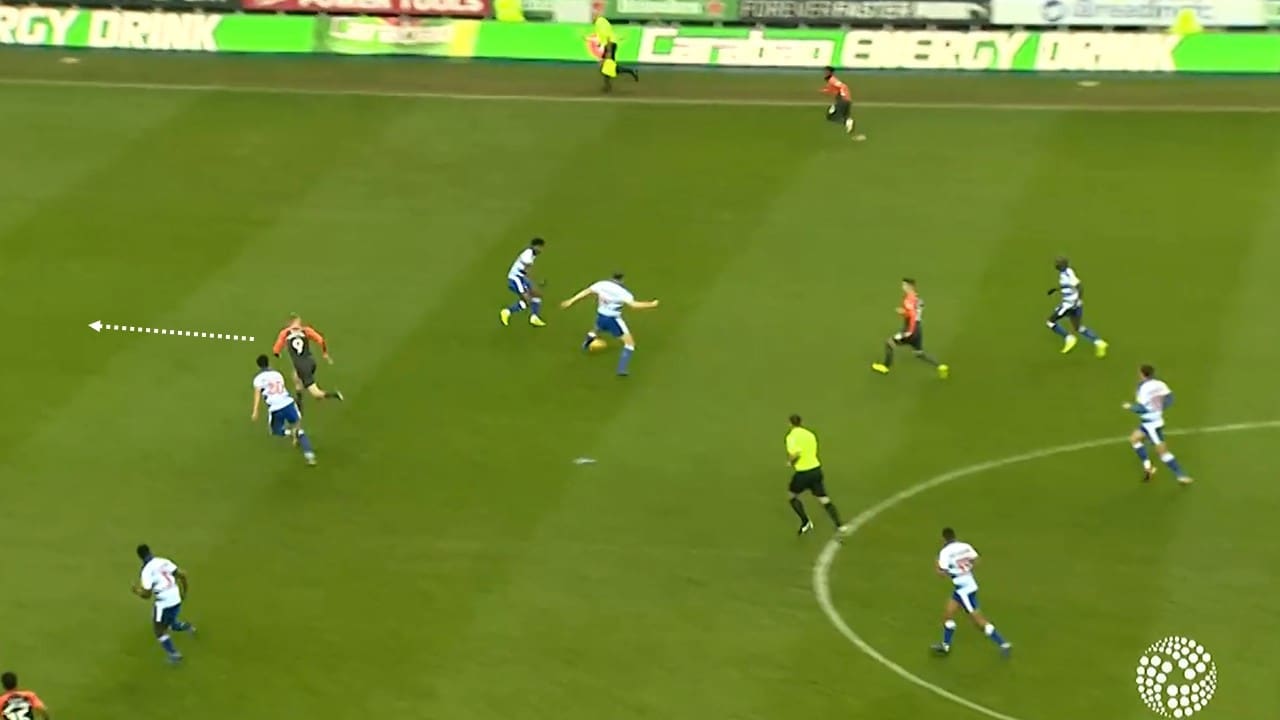
Wigan all over the place and an ineffective press
Usually, a tactical match analysis will aim to break down the key tactical battles between two sides and how either side were able to create goalscoring chances. It can’t be ignored that Reading were simply all over the place for the first 15-20 minutes at least.
They adopted a careless, ineffective high press without good structure and planning. As the manager commented after the game, his players were “scared”, particularly from getting close to Swansea’s players and making a challenge or interception. This led to a goal after just 90 seconds and it was an overly simple one.
As you can see from the image below, there is no pressure on right-back Kyle Naughton. With two Reading players close to the advancing Nathan Dyer, he decides to cross for McBurnie inside the penalty area.
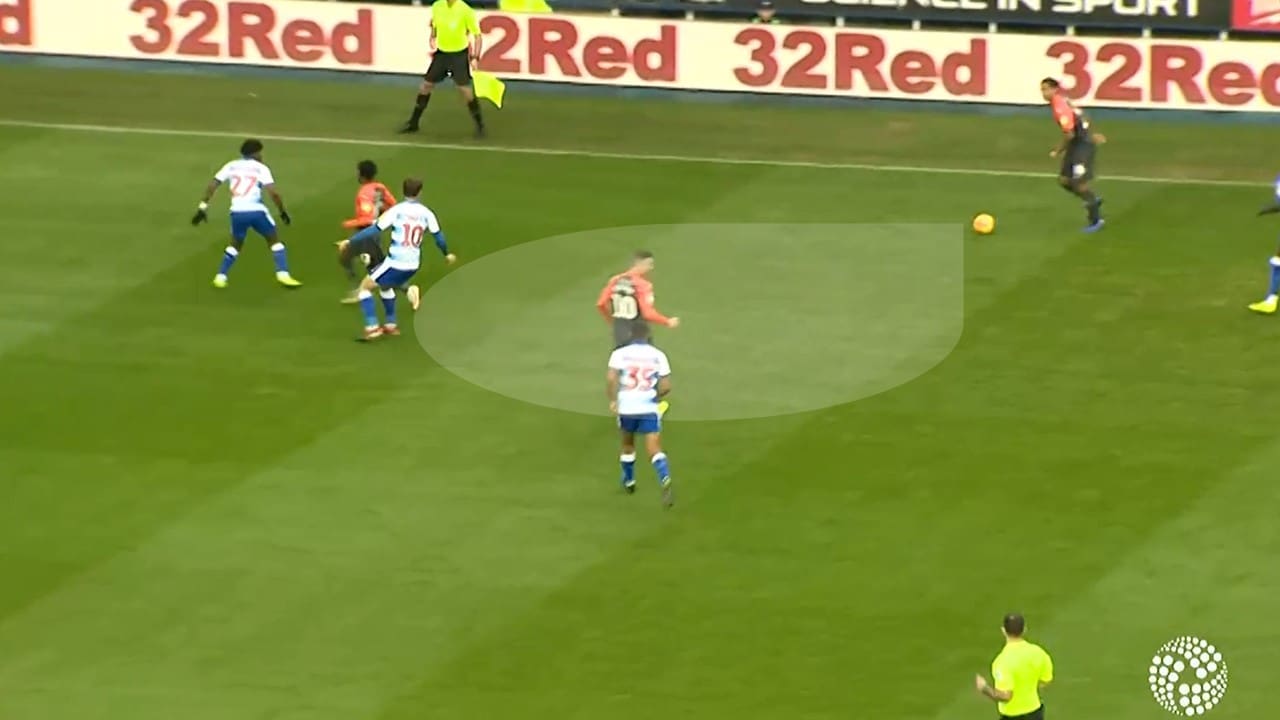
McBurnie is marked by two Reading defenders, but despite this he’s able to win the aerial challenge. He superbly direct his the ball past the goalkeeper and into the left corner of the net. That’ll go down as a very low xG value and rightfully so: it was a brilliant finish.
You will also notice how, in fact, it was a good decision from Naughton to make the cross. Knowing McBurnie is capable of challenging well in the air, even if he doesn’t win the challenge, Wayne Routledge is available in plenty of space to pick up a loose ball inside the box.
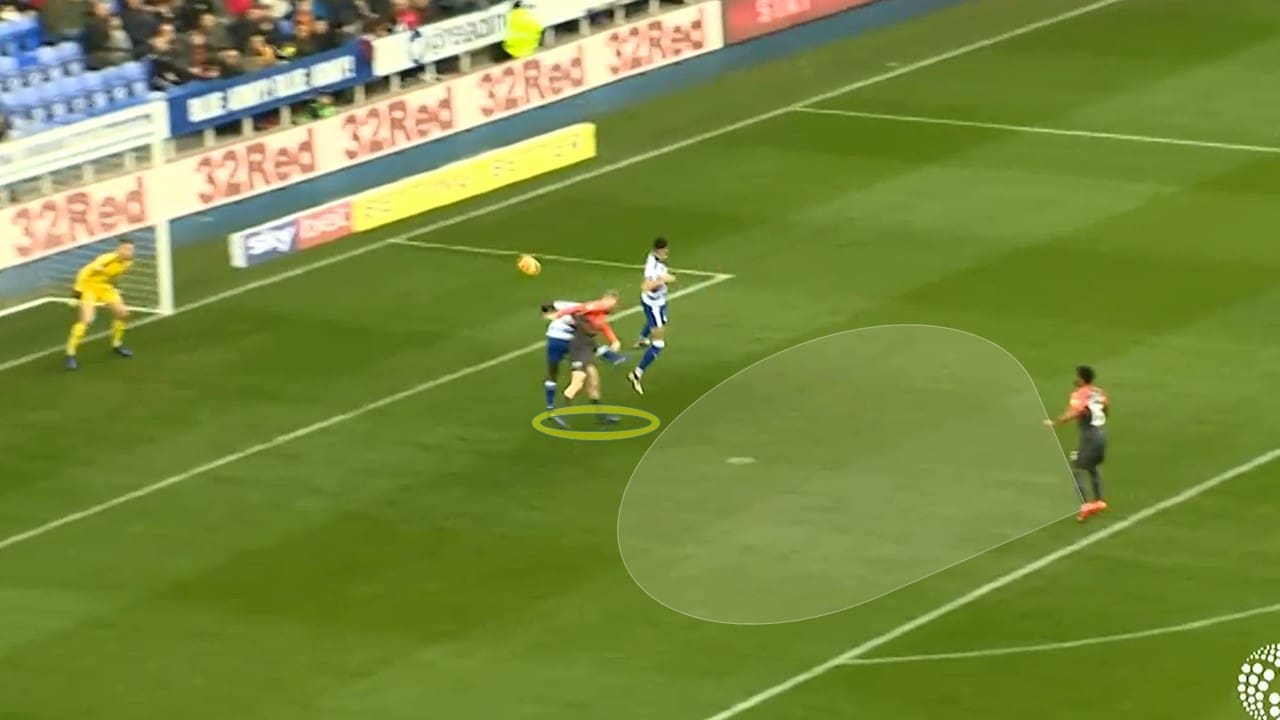
Back to Reading’s poorly executed high press. Swansea City found it relatively easy to evade, partly because it lacked enough intensity. Potter’s side never really had to play the ball around efficiently and quickly to avoid losing possession in their own defensive third. Behind Reading’s leading pressers, they didn’t close down the space occupied by Swansea’s wide outlets of Wayne Routledge (left), Kyle Naughton and Nathan Dyer (right).
Below shows a long ball being played up to Bersant Celina. One Reading player is chasing back but Celina can make a first time pass to the near side for left back Connor Roberts to move forward.
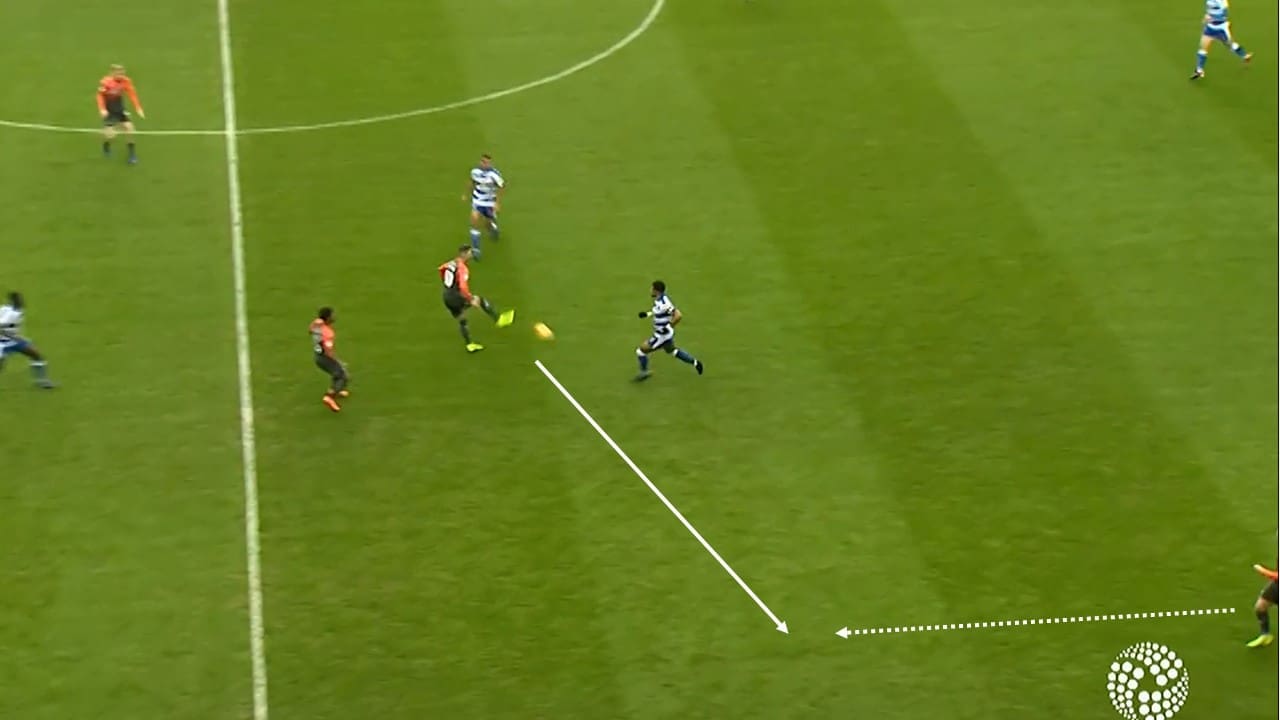
As a result, even when Reading did manage to force Swansea City into making more rushed long passes out from the back, they could still maintain possession rather easily due to a lack of intensity and effective positioning to block passing lanes.
Below is a typical example of shortly after Swansea have regained possession deep in their own half. Reading look to press. Circled is Swansea City captain Leroy Fer who is pointing over to the far side to where the ball needs to go to start a counter-attack.
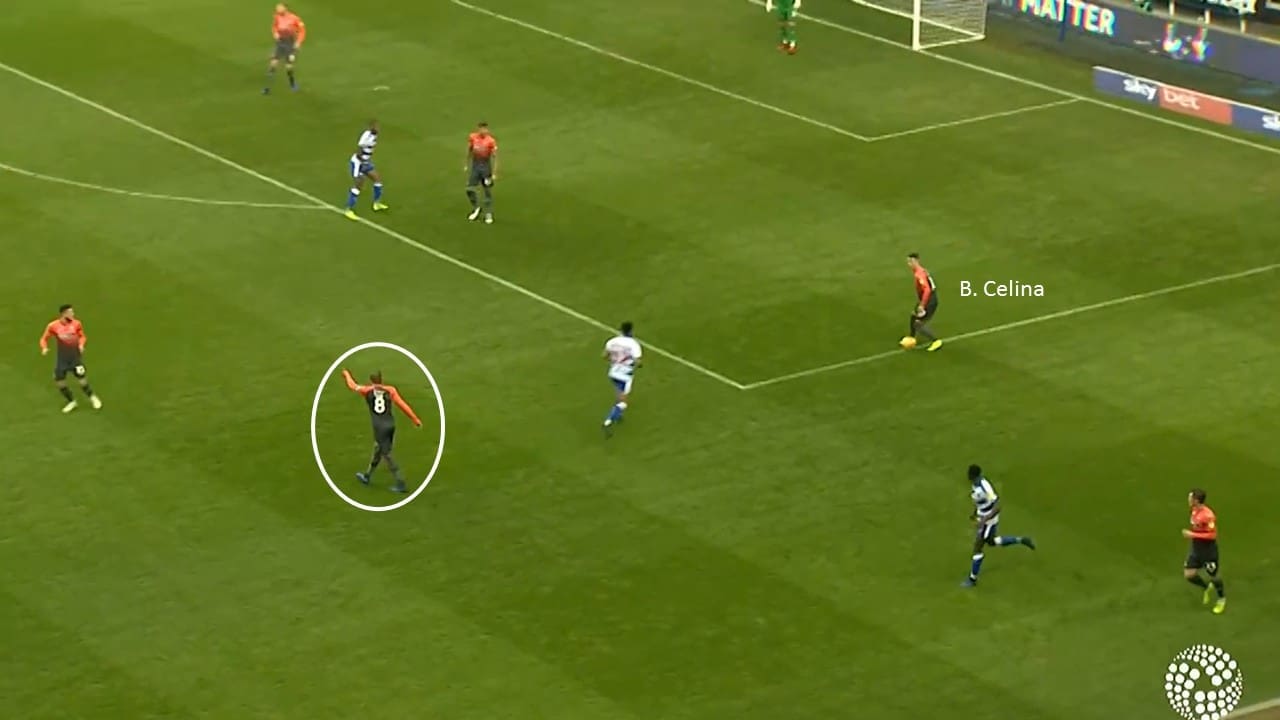
The ball soon comes to Leroy Fer. As he had indicated, he quickly switches play to right-back Kyle Naughton, who has plenty of space to move into. Also circled in blue is left winger Modou Barrow who we’ll see many times during this tactical analysis. He was forced to chase back and get into defensive positions regularly.
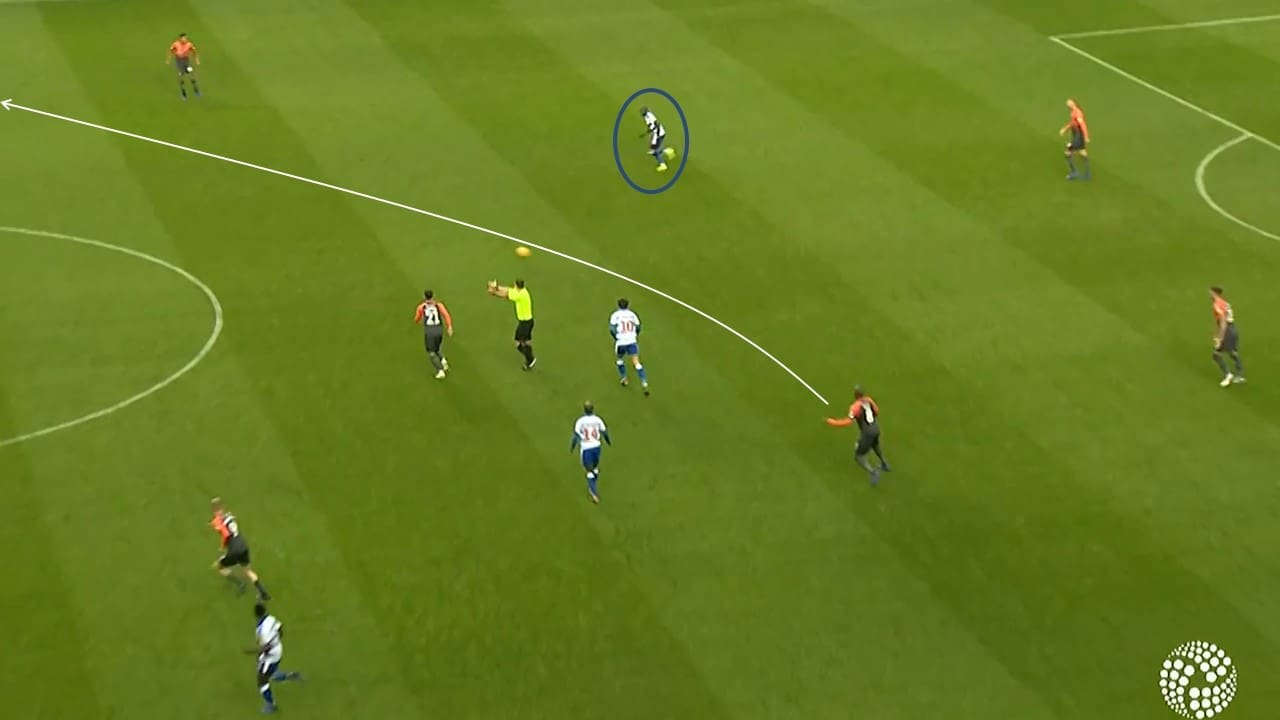
Swansea’s effective shape
Reading’s pressing completely contrasted with that of Swansea’s, which was far more effective. This allowed them to force simple mistakes and block key passing lanes into wide areas.
Below shows a large shaded area of space in the centre, just inside Swansea’s half. Reading, however, can’t make use of it. Swansea press effectively enough here but the home side were rather sluggish and slow in moving the ball into key areas. Sometimes they took the wrong option and made careless mistakes that led to possession breaking down a number of times in the first half.
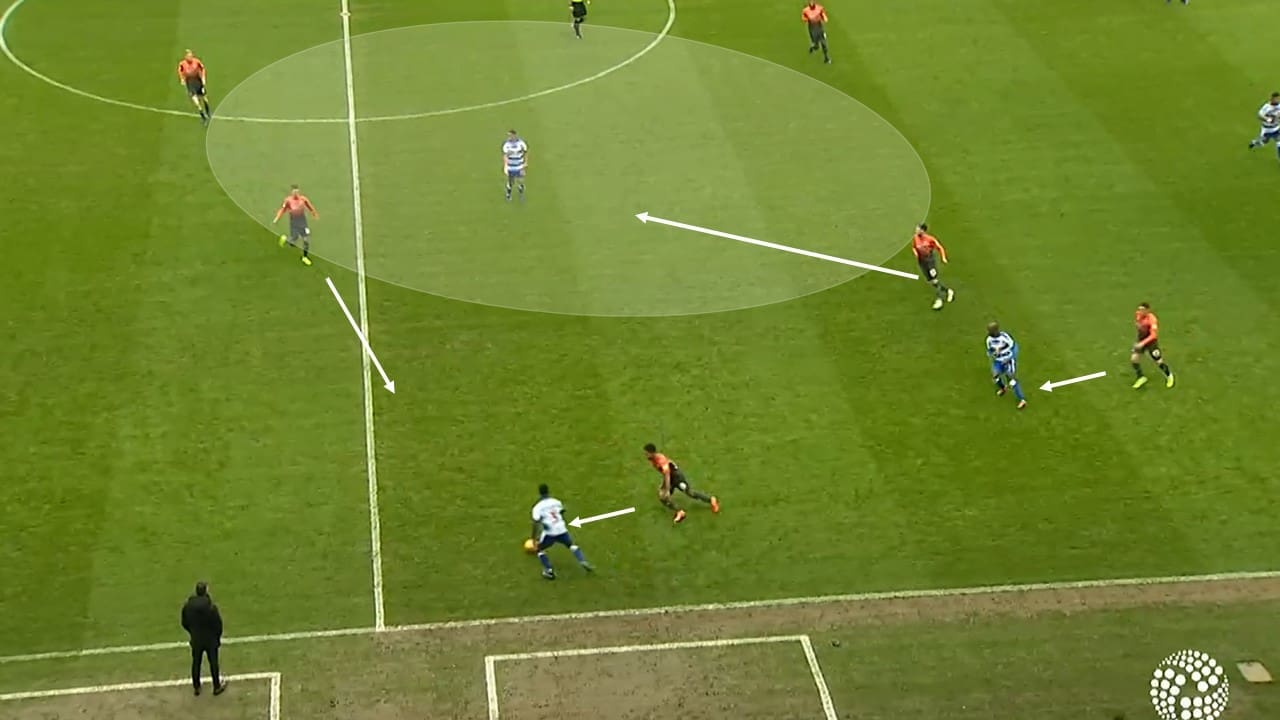
Swansea City again press effectively below. It’s never been an overly intense press from Swansea this season, but a balance of pressing forward when needed with other players well positioned to block passing lanes make it an effective enough weapon out of possession.
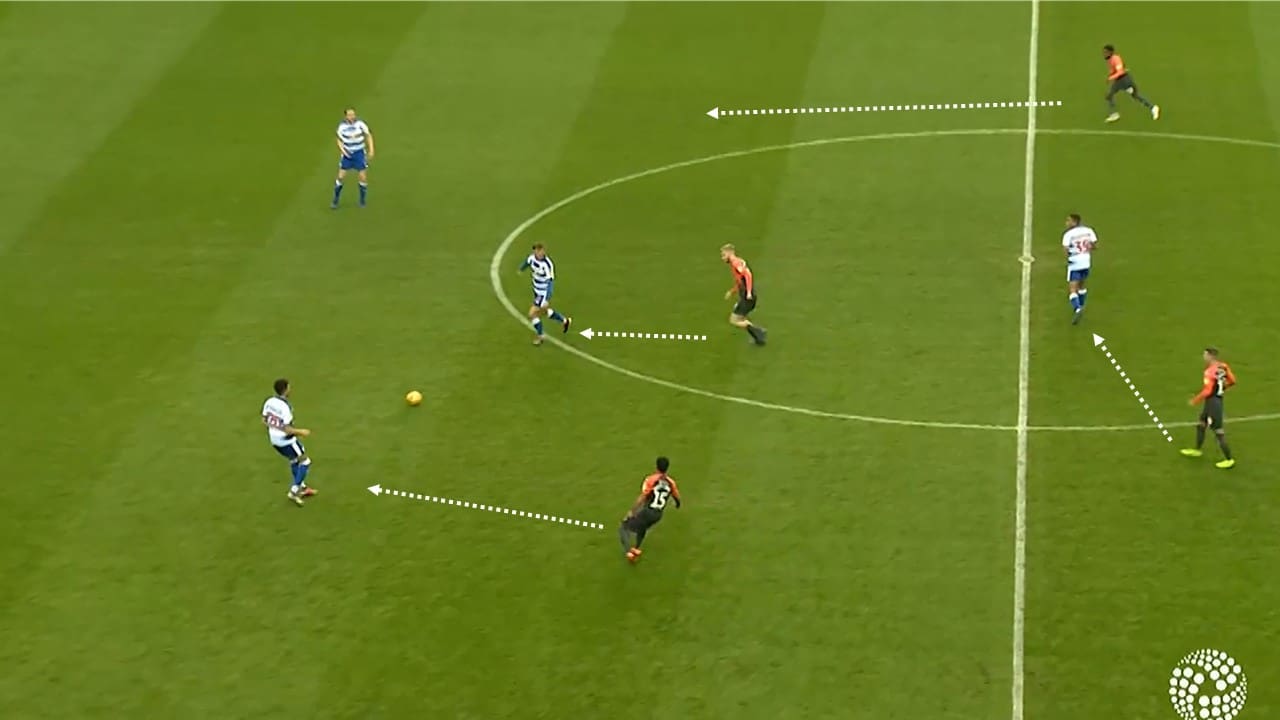
Here’s another example of Swansea doing enough to press and break up Reading’s forward movement. As we mentioned, Reading often took the wrong option. Below, a player moves inside rather than taking the option down the left where two Reading players are only marked by a single Swansea City full-back.
Swansea outnumbered Reading through the middle. While Leroy Fer presses the player in possession below, Grimes is well positioned to block the forward passing option. Celina too blocks a pass backwards into defence. If Swansea can win possession here, there’s a counter-attacking opportunity awaiting.
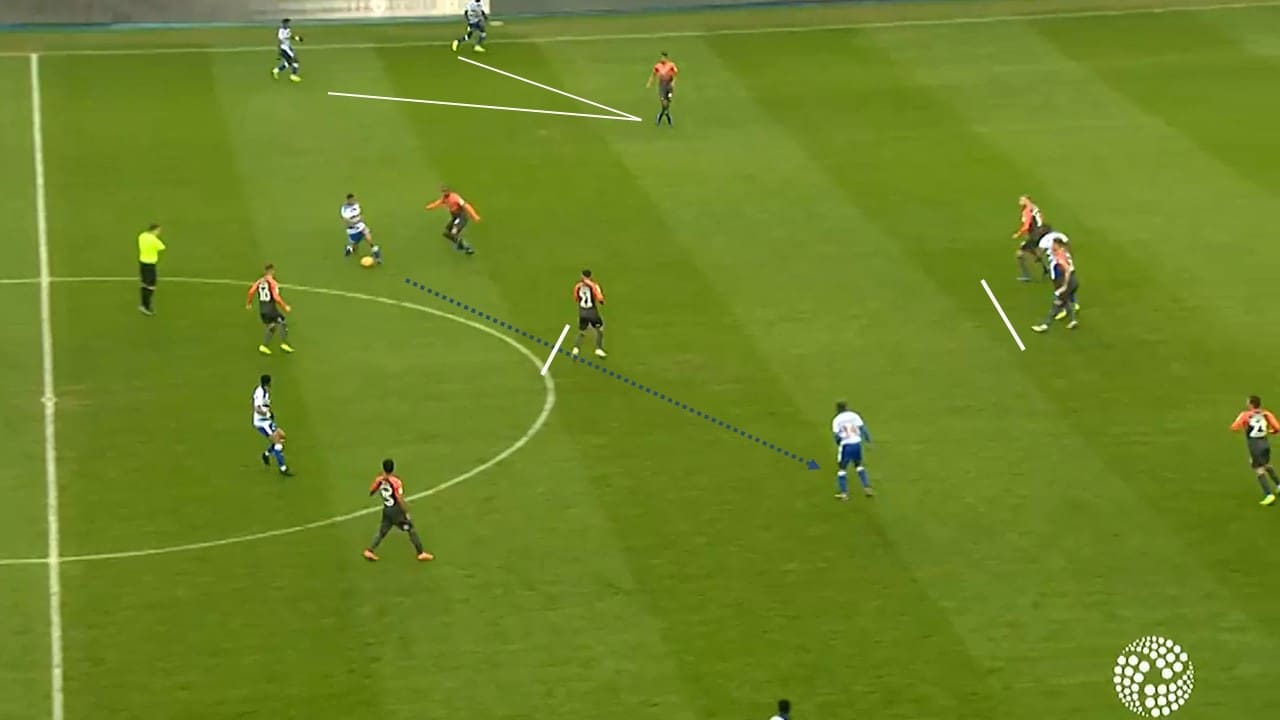
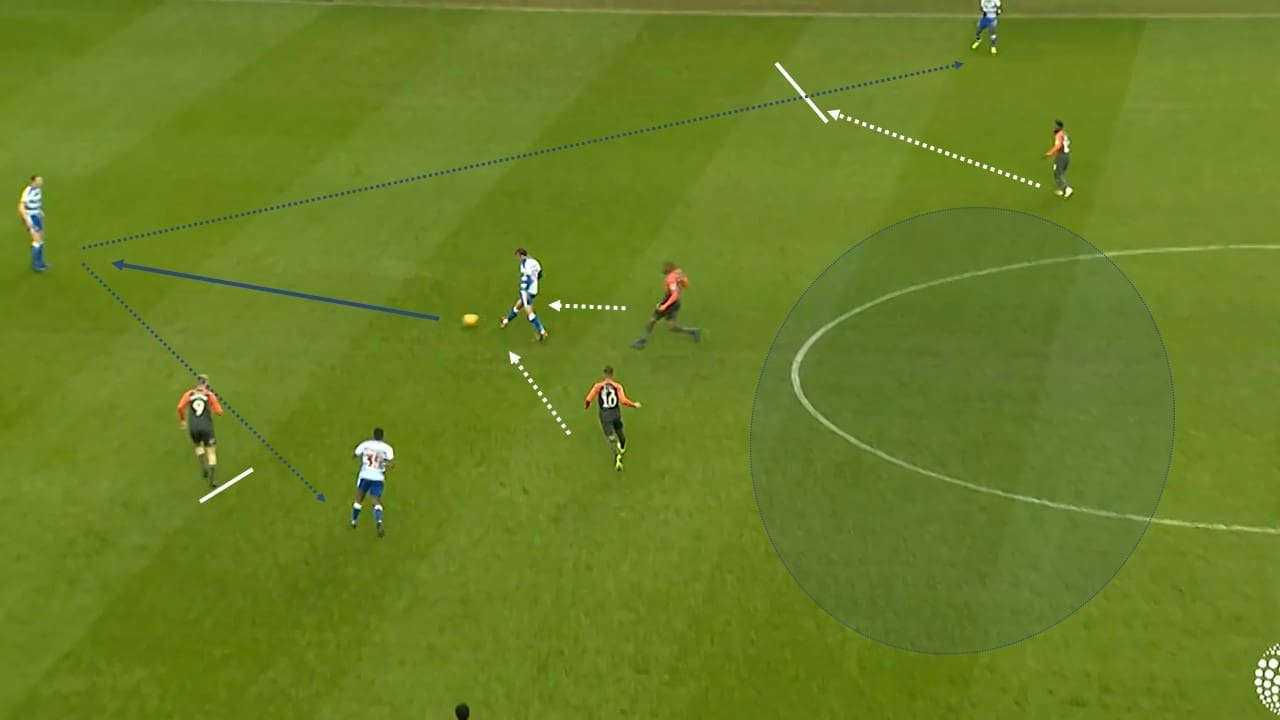
Below is yet another example of how Swansea’s press was effective and how it was primed to counter-attack. One player presses the Reading player in possession. In this example, it’s Swansea’s number 10, Bersant Celina.
Shown by the white dotted line, Leroy Fer moves forward to press the most likely Reading player about to receive the ball. The two wingers, Wayne Routledge and Nathan Dyer, are circled. They are ready to attack the large spaces in front of them if their team-mates can win possession.
McBurnie, positioned just above Celina and the Reading player in possession, is equidistant to the triangle of Reading players. This makes him perfectly positioned to act upon the next action from the opposition.
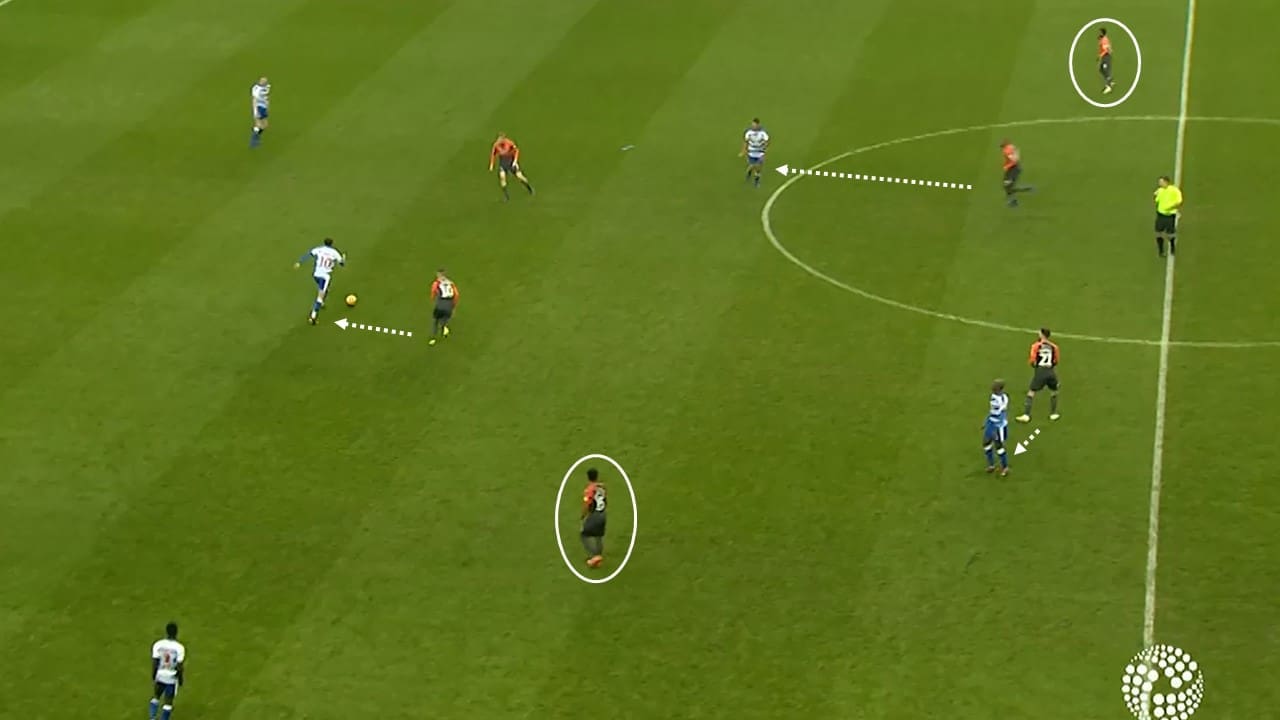
Swansea’s width stretches Reading
Swansea City always wanted to ensure that they had attacking width to stretch a narrow Reading side.
Below we again see Modou Barrow chasing back from his high press involvement as Wayne Routledge looks to play Kyle Naughton in behind down the right. With Naughton providing the width, Nathan Dyer can come off the touchline and offer attacking support through the middle. This ensures that a Reading defender is kept occupied by his forward movement.
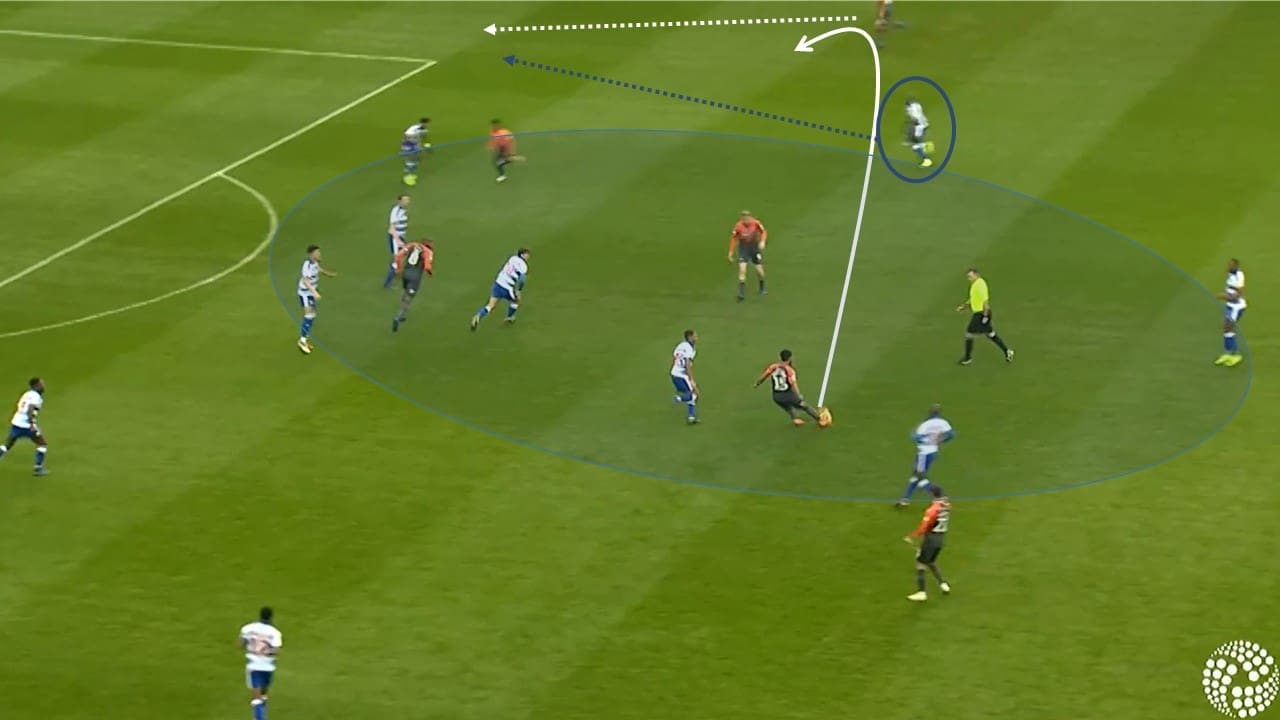
On occasion, non-wide players would shift out wide to offer an attacking option. Celina, a central attacker, moves out to the left, allowing his side to switch the play. They can make use of the flanks to stretch the opposition as a Reading full-back comes across to challenge him.
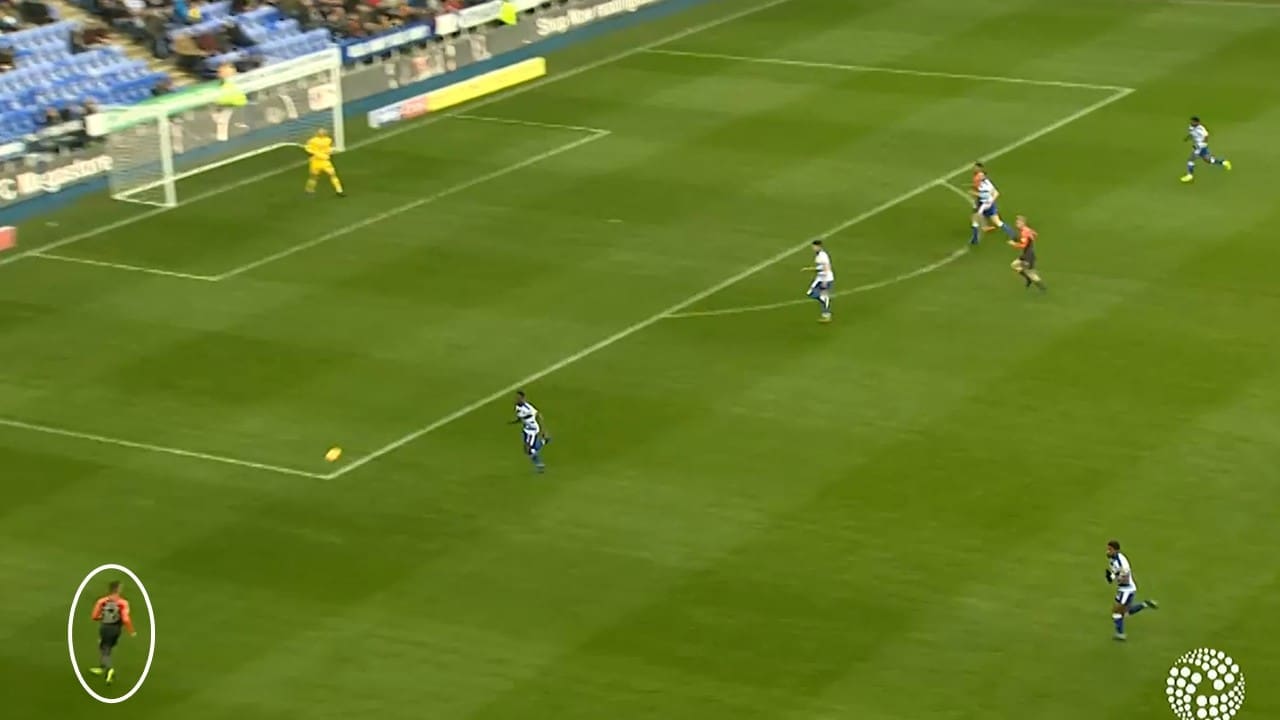
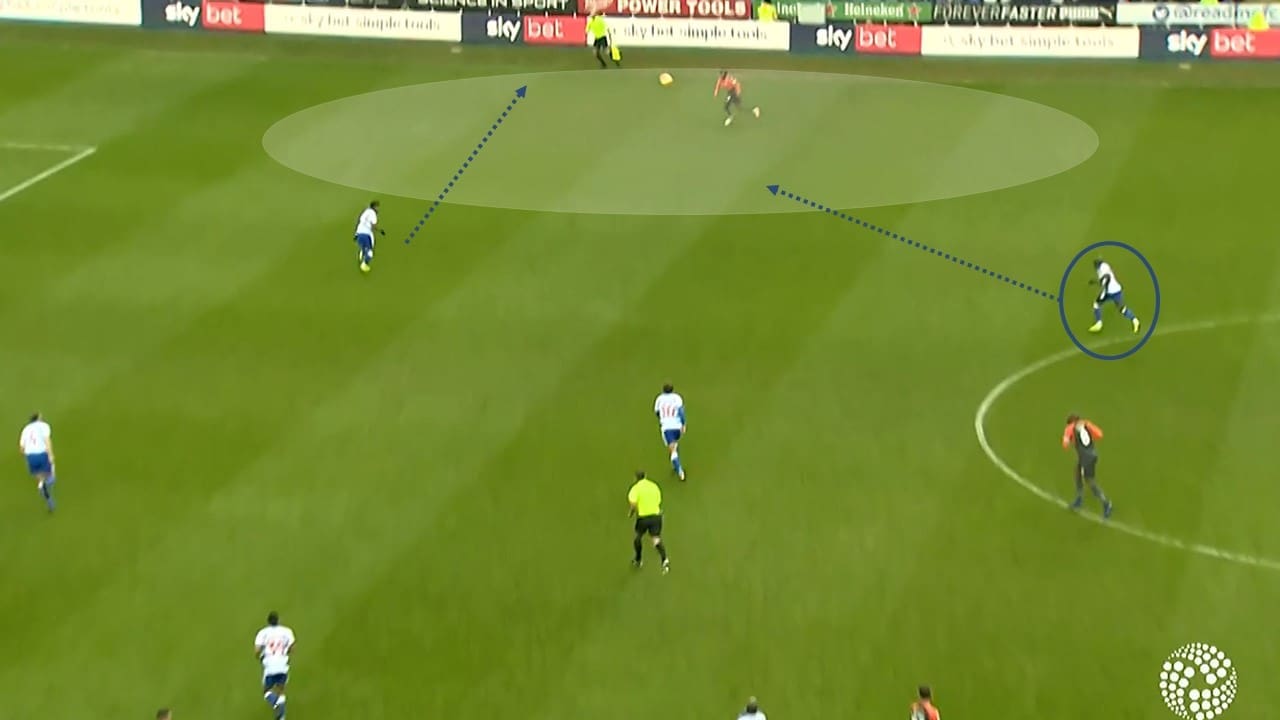
Reading make sloppy mistakes, Swansea City take full advantage (for a change)
Reading were guilty of their own downfall in this game. Swansea City have played better this season and failed to win. This,though, was a rare occasion where they took full advantage of their opposition’s failings. Swansea City double their lead on the half-hour mark after a poor clearance from Barrow near the touchline.
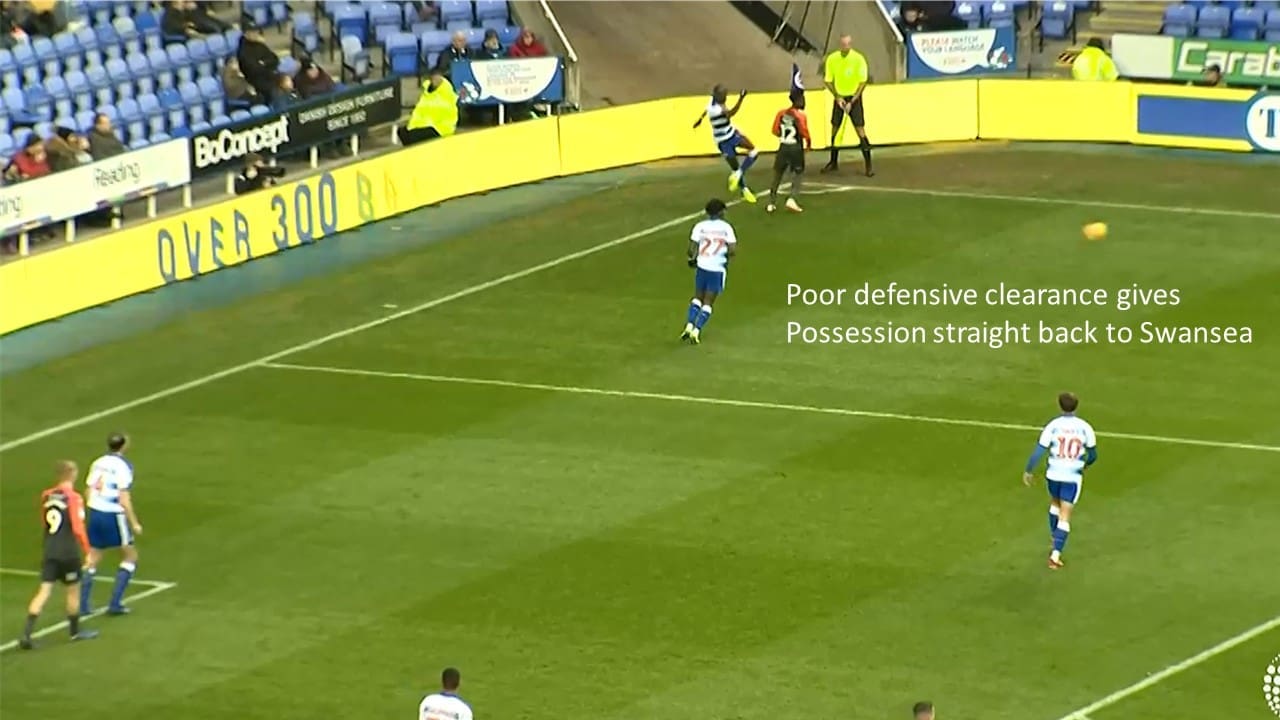
After regaining possession, Swansea City then play the ball back and inside to Bersant Celina. He brilliantly lifts a delightful ball over Reading’s defence for Leroy Fer to head across the penalty area.
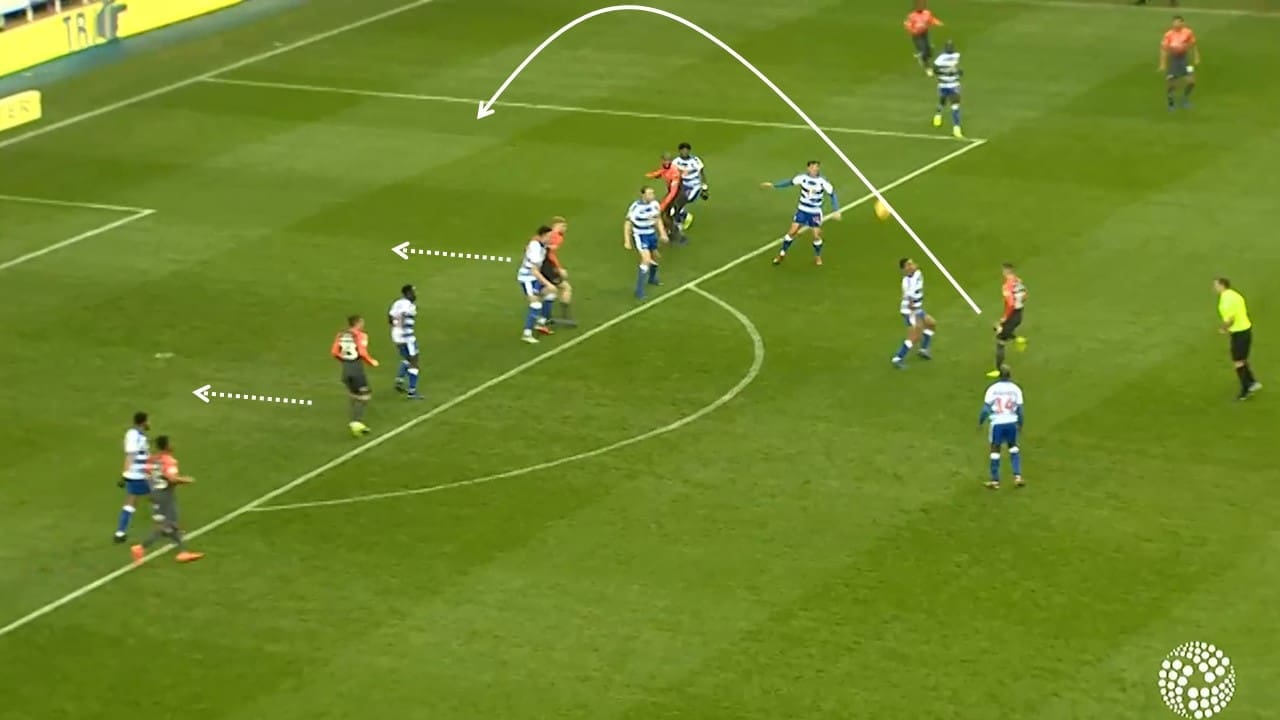
Reading’s defence are left flat-footed (circled). McBurnie and Roberts can both run through in behind the defence waiting for an easy finish. McBurnie can’t get there but full-back Roberts is available at the far post for the easiest of finishes.
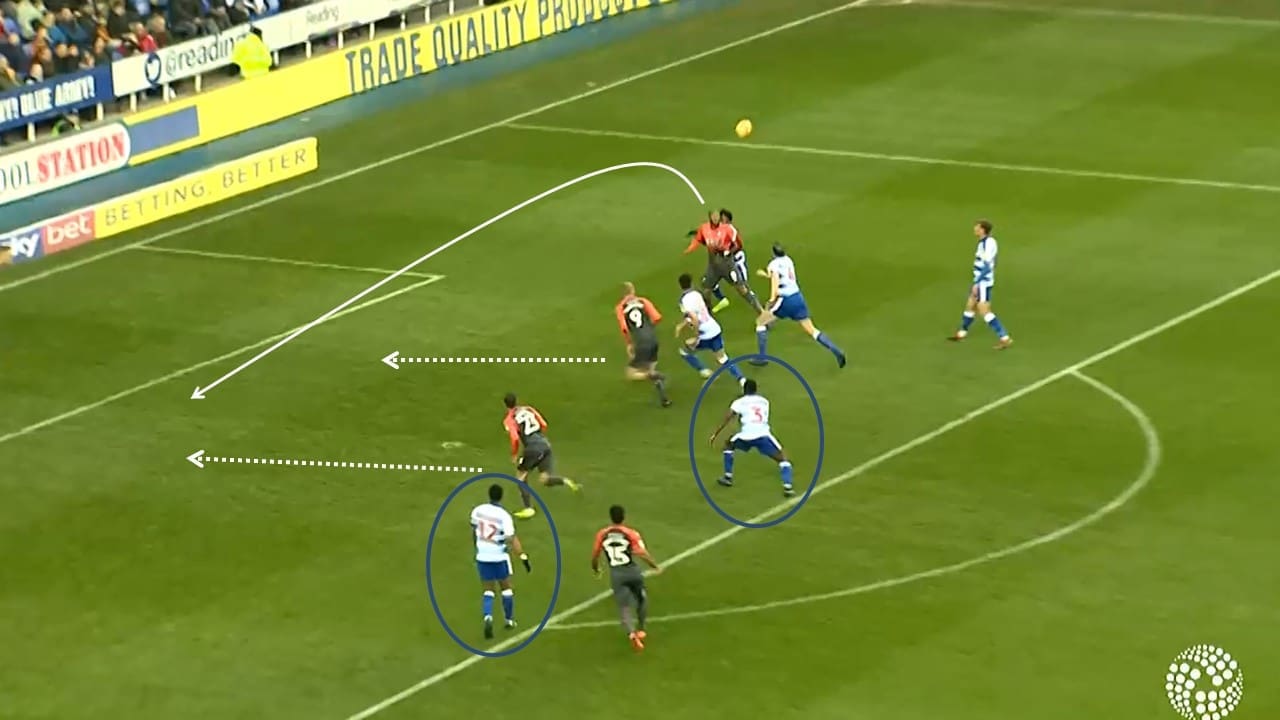
Swansea City’s third goal, on the stroke of half-time, is another simple one in terms of its execution. The delivery of Matt Grimes’ indirect free-kick is excellent, however. Initially only Bersant Celina had stepped over to take the set piece. At the final second, Matt Grimes came across to take over the free-kick duties.
Thankfully he did from Swansea’s perspective. He curled in an inviting, out-swinging cross, in behind a row of Reading defenders. None of them got back to clear the cross. Defender Mike van der Hoorn got in behind his marker at the far post to steer the ball into the net for his second goal in as many games.
Again, the delivery is excellent but it’s too easy from Reading’s point of view. Manager Jose Gomes will be wanting his side to stop the cross and win the aerial challenge for the first, not make poor clearances and pick up unmarked players for the second, drop back for the third goal below and lastly, not be clumsy and concede an easily avoidable penalty. The last gifted Swansea a 4-0 lead after just 47 minutes.
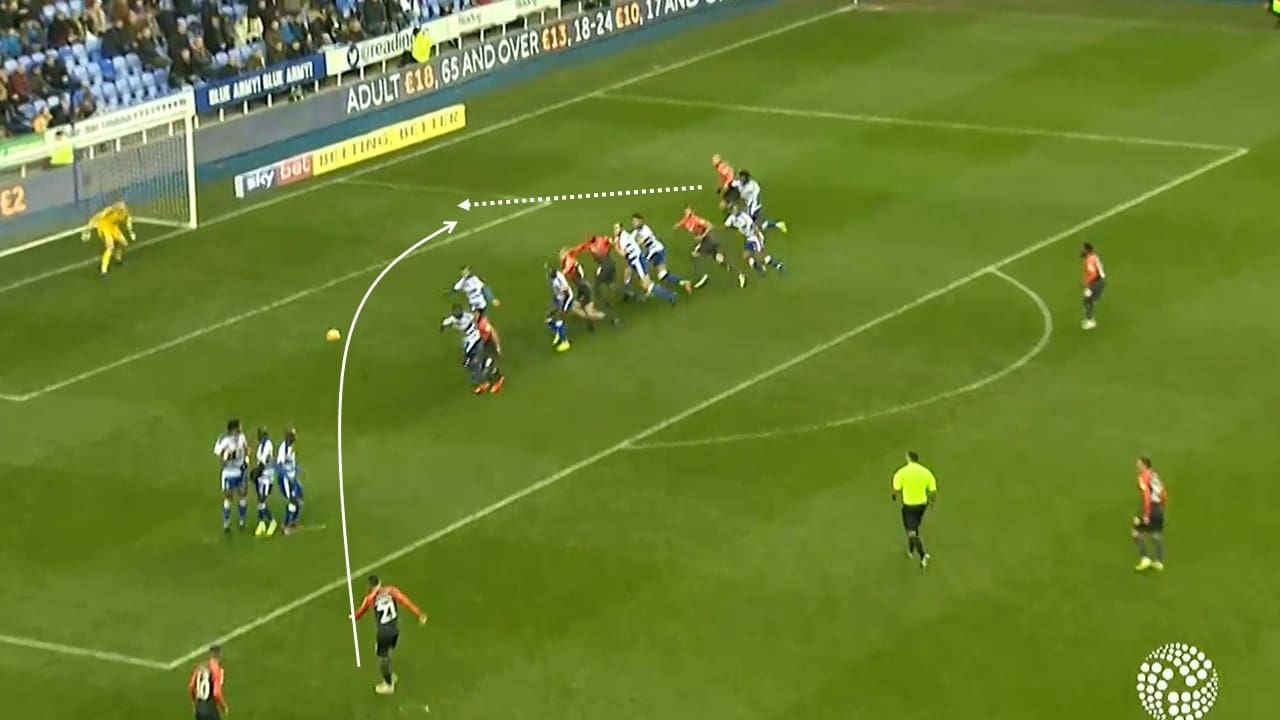
Reading continued to make mistakes throughout the first half. Sometimes it was simple poor passes from deep, like this one below from veteran John O’Shea who sees his long diagonal go out of play.
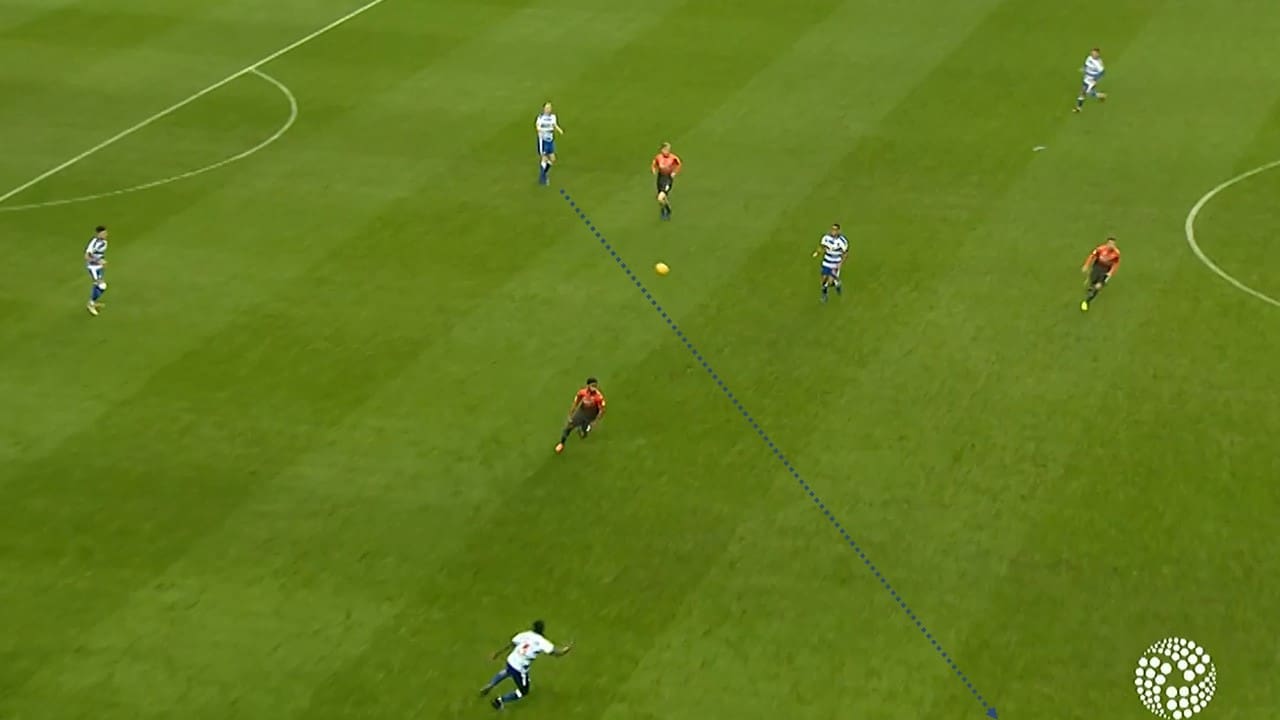
Below is a screenshot just after a poor back-pass gifts Swansea a chance to wrap the game up at 4-0 within the first minute or so of the second half. Gaps quickly appear in Reading’s back line and Routledge (in possession, below) can play a pass through for McBurnie but he delays a shot on his left foot and the chance leaves him.
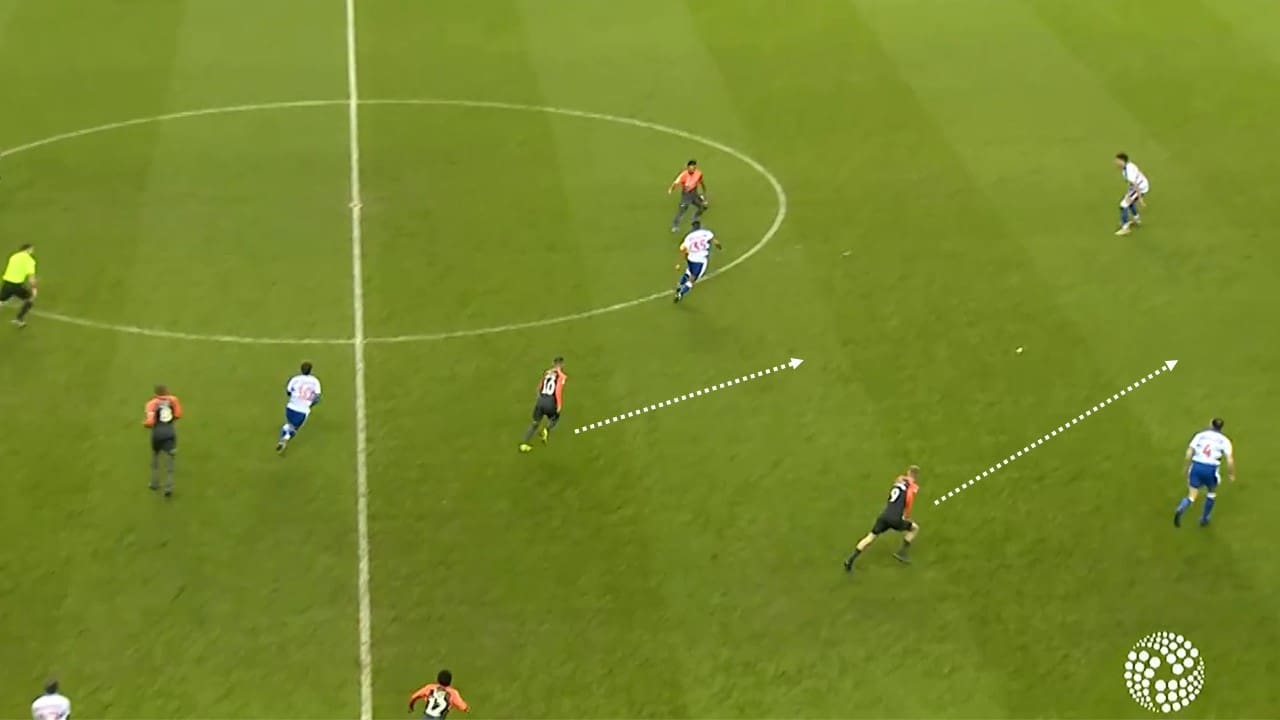
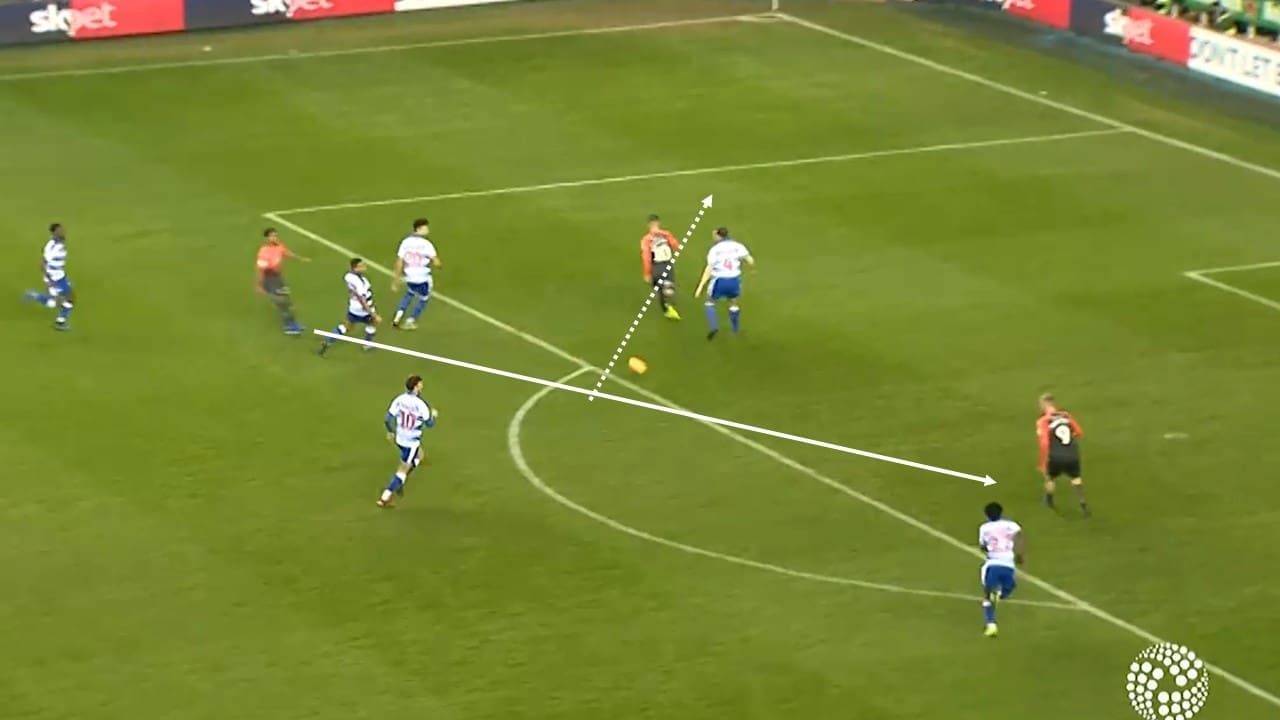
Large open spaces kept opening up between Reading’s centre-backs. This time it’s Dyer running through the middle, but Swansea can’t extend their lead even further from these clear openings.
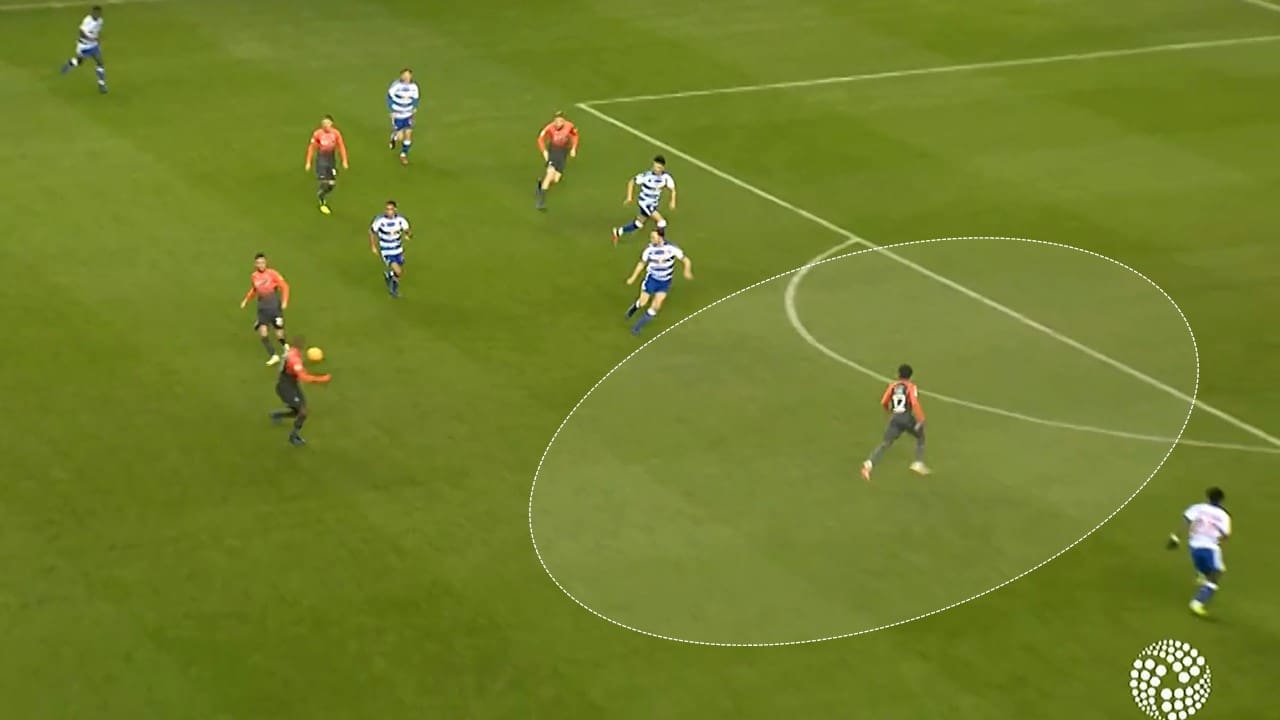
Reading play for pride in second half
Despite trailing 4-0 from the 47th minute, Reading do deserve some credit for not giving in at least. They were ultimately playing for pride in the end and for those die-hard supporters who stayed until the bitter end.
They increased their intensity in the second half, made better decisions in possession and fixed their high press issues.
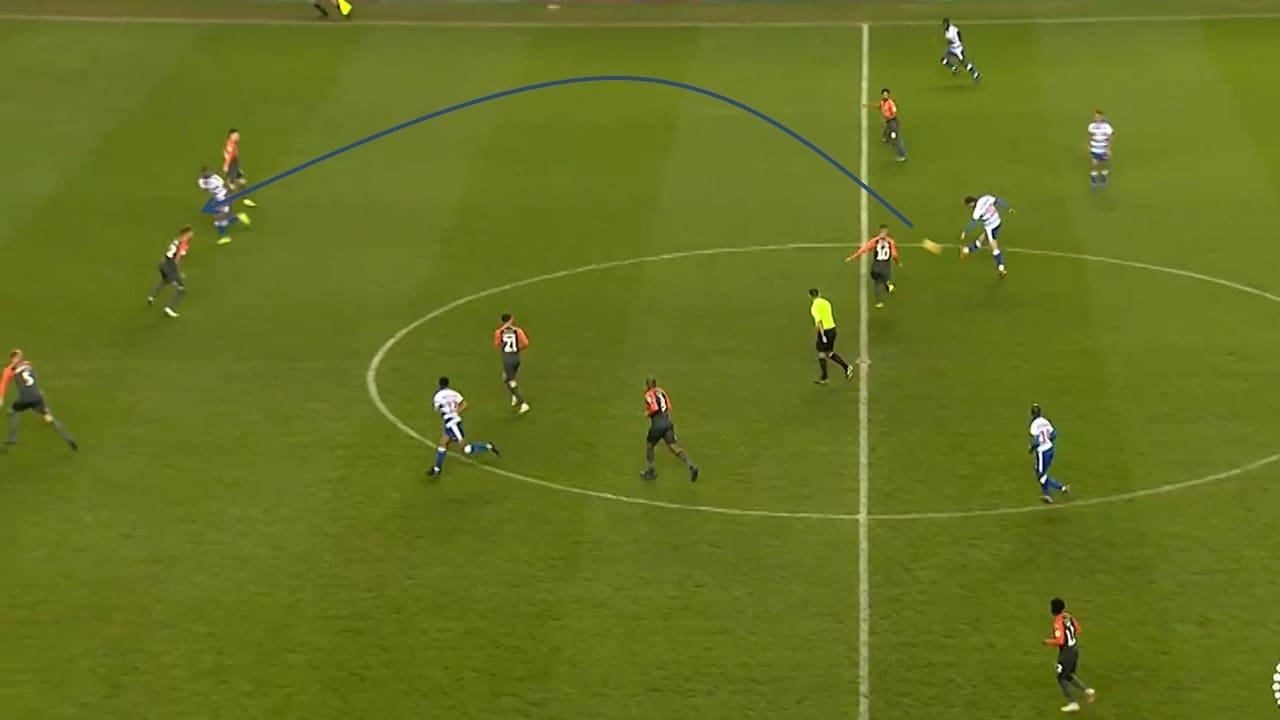
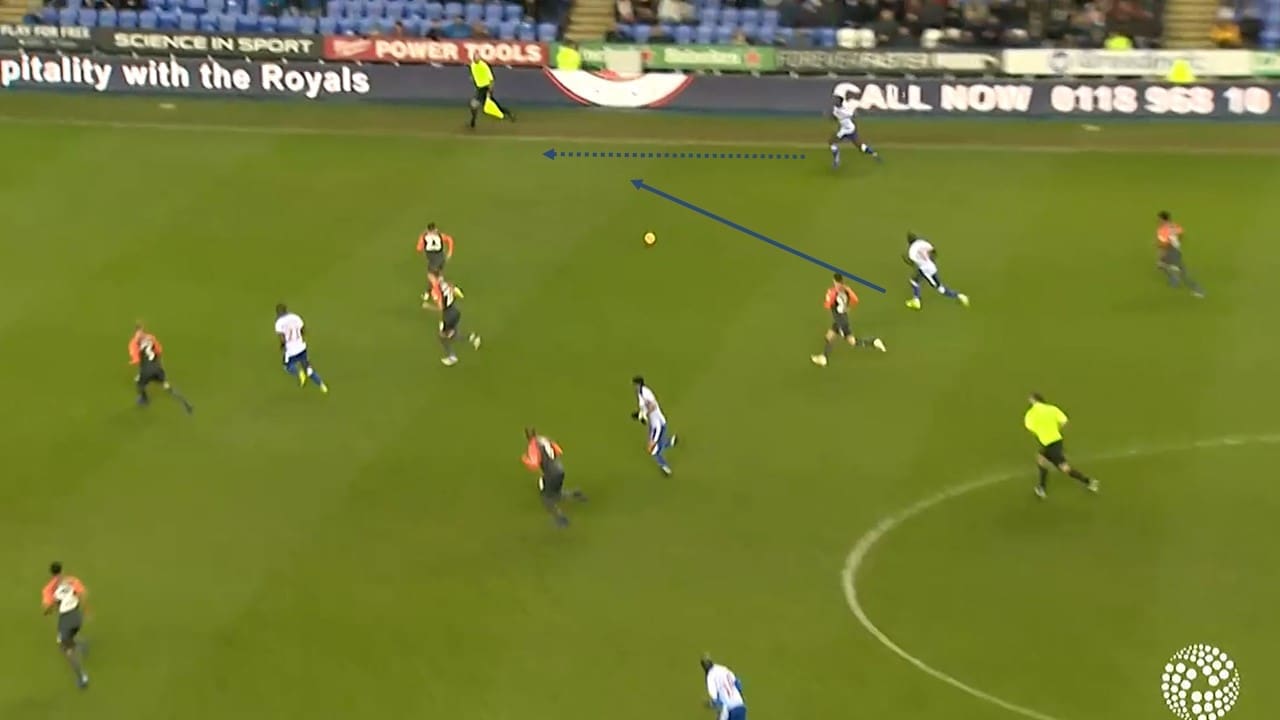
Swansea sit deeper to protect 4-0 lead
Rather than seeking more goals and building on their 4-0 lead, Swansea manager Graham Potter was happy enough and told his side to sit deeper in a defensive block. He was likely hoping to maintain a clean sheet having not kept one since their visit to Wigan way back in November 2018.
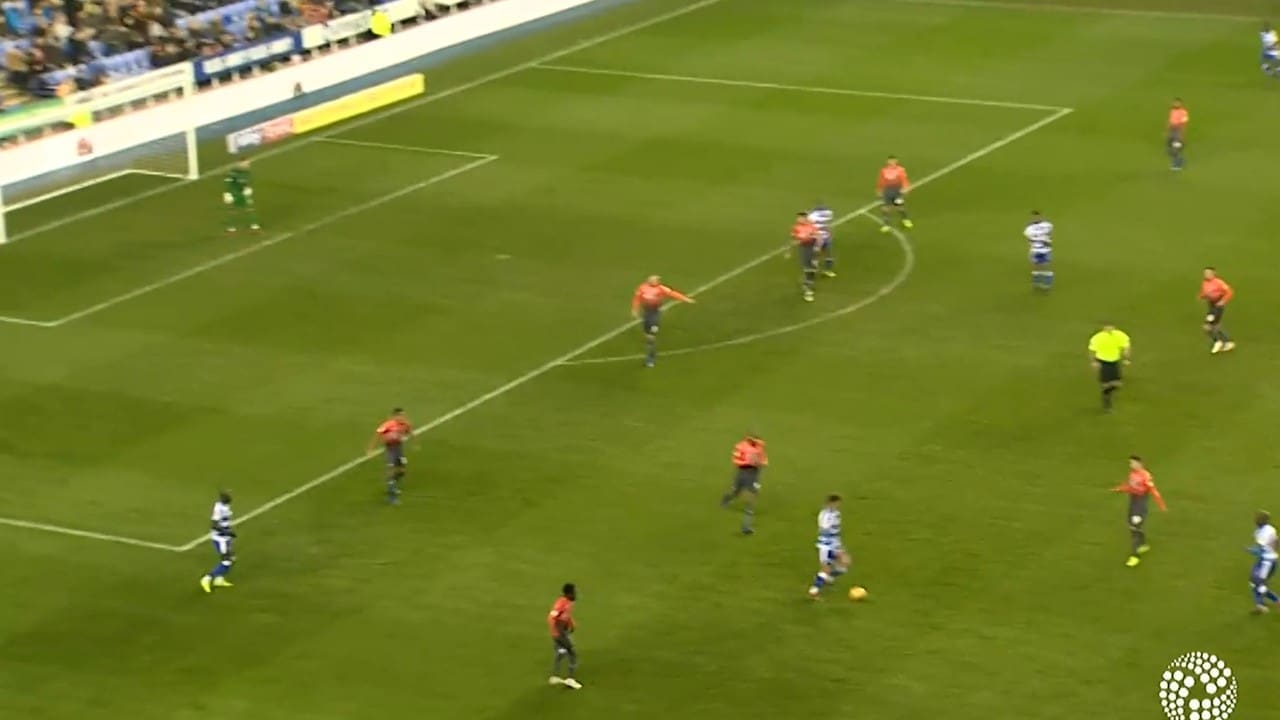
Despite sitting deeper, Swansea City did press high at times, looking to steal possession high up the pitch. This was their main source of opportunities to add to their comfortable four-goal lead in the final 20 minutes of the game.
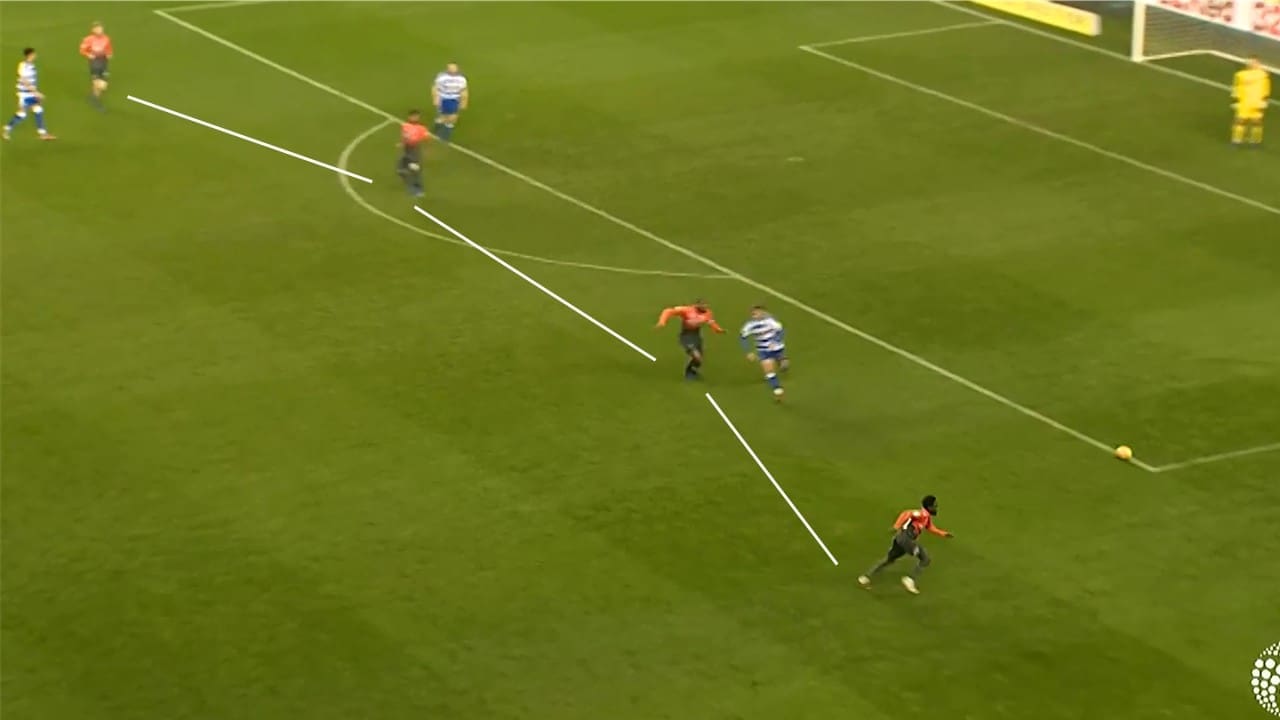
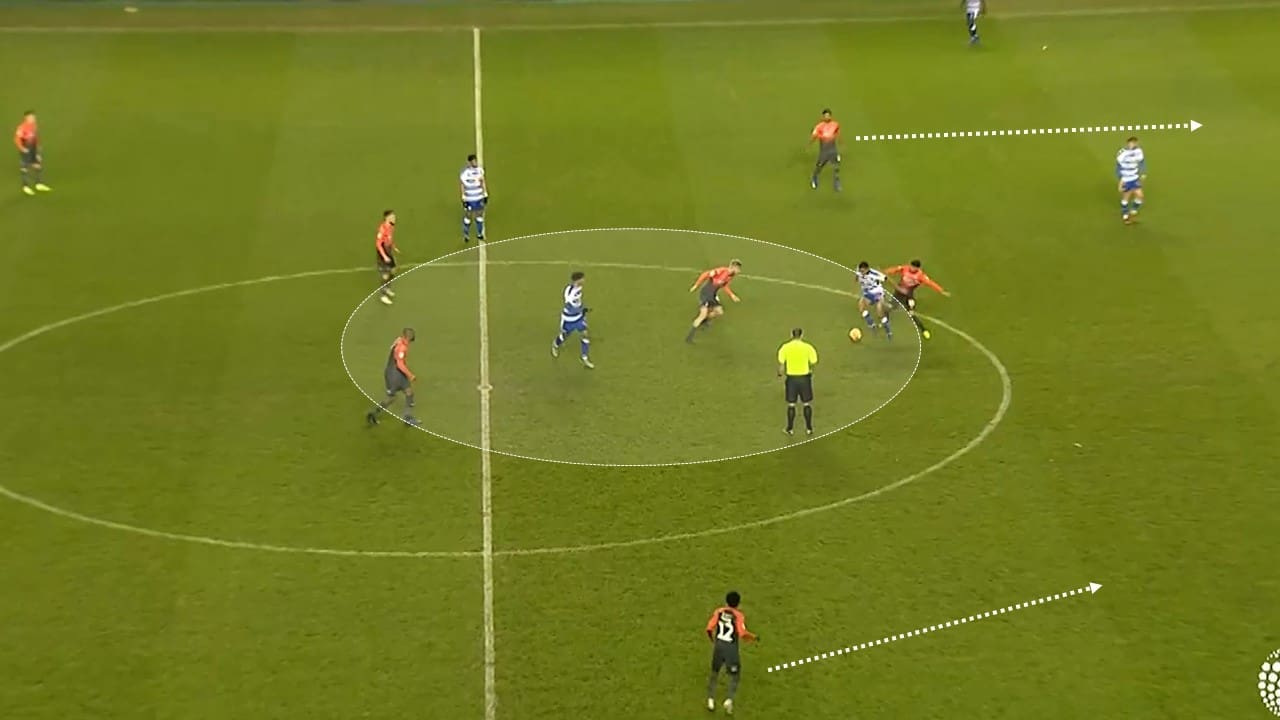
With Reading finally making more use of their flanks, Swansea began to drop Wayne Routledge deeper in their defensive line to support fullback Connor Roberts.
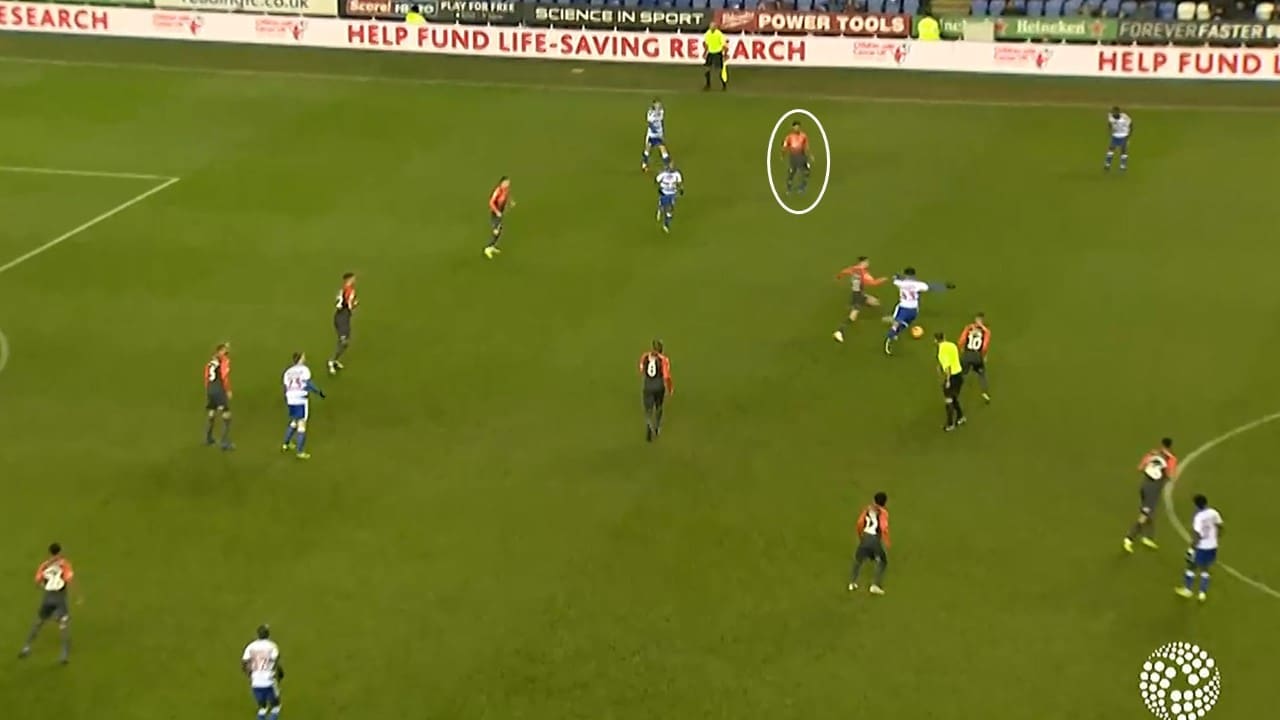
Reading score late consolation
Swansea City will have to wait for their clean sheet as Reading did score a late consolation goal as a reward for their second-half efforts. They reacted quickly to a free kick inside Swansea’s half, playing a quick forward pass while Swansea were slow to react.
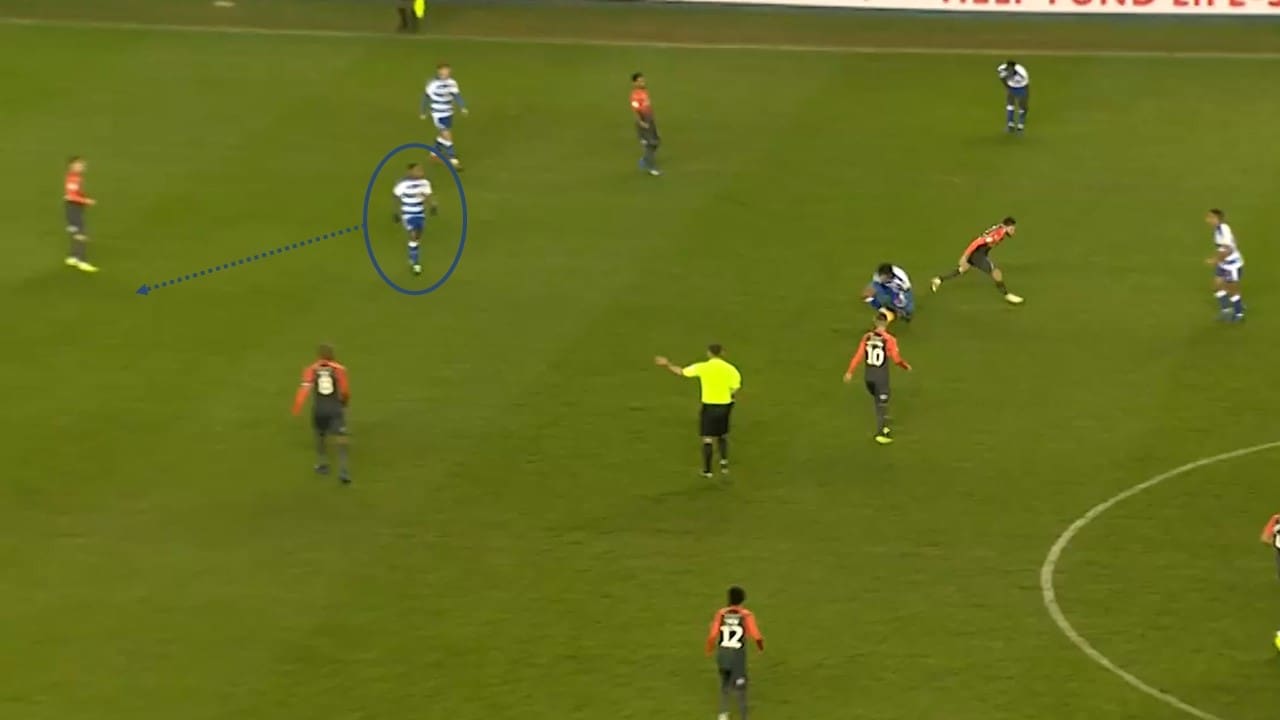
Leroy Fer misses a challenge. As he does, the ball is slipped through for Harriott who confidently fired the ball past Erwin Mulder.
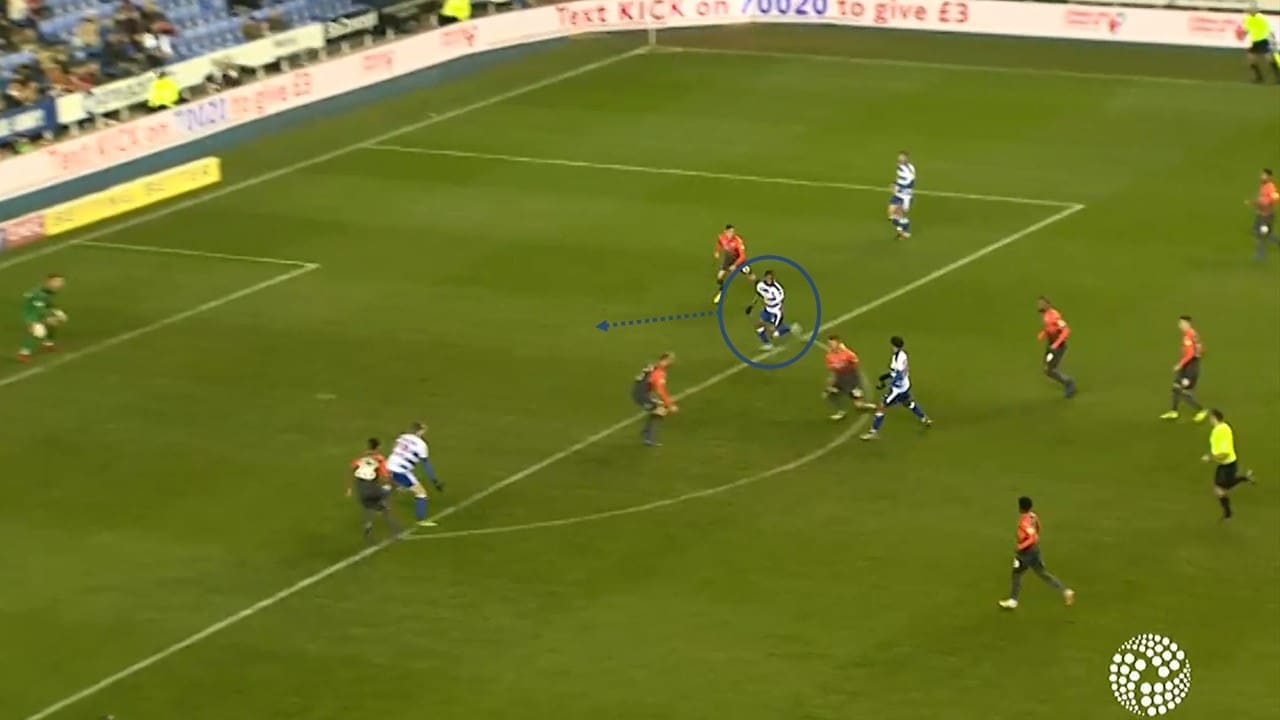
Summary
It was an emphatic victory from Swansea City who were in much need of a win after two defeats and a comeback draw over the festive period.
They played a more counter-attacking style, something they had adopted earlier on in the season. They were happy to go direct as opposed to playing patient build-up play from the back. In the second half they were content to sit back and counter, allowing Reading 73% possession. Their defensive shape didn’t quite do enough to keep a clean sheet.
It was a very worrying first-half performance from Reading. The new manager has got his work cut out to guide them to safety this season. Weak defensively and lacking firepower, they’ll surely need some reinforcements in the transfer window this month to ensure their Championship status. Unless Gomes can work some miracles, it looks a very tough ask on this showing.
If you love tactical analysis, then you’ll love the digital magazines from totalfootballanalysis.com – a guaranteed 100+ pages of pure tactical analysis covering topics from the Premier League, Serie A, La Liga, Bundesliga and many, many more. Get your copy of the FIRST of two December issues for just ₤4.99 here, or the SECOND of the December issues with an annual membership right here.

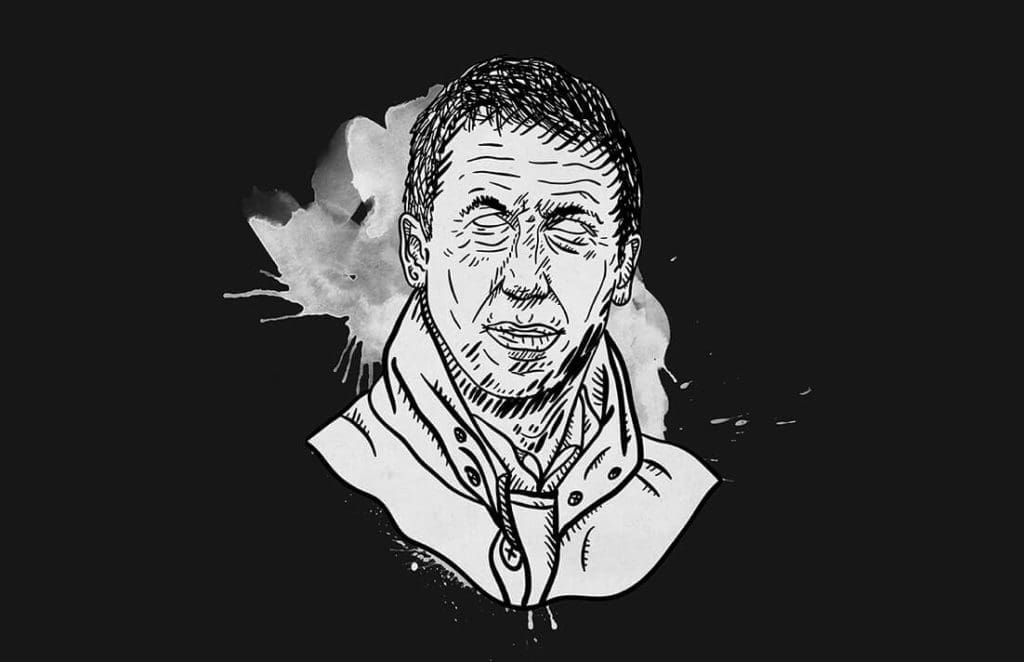



Comments